2018 KIA K900 wheel
[x] Cancel search: wheelPage 400 of 544
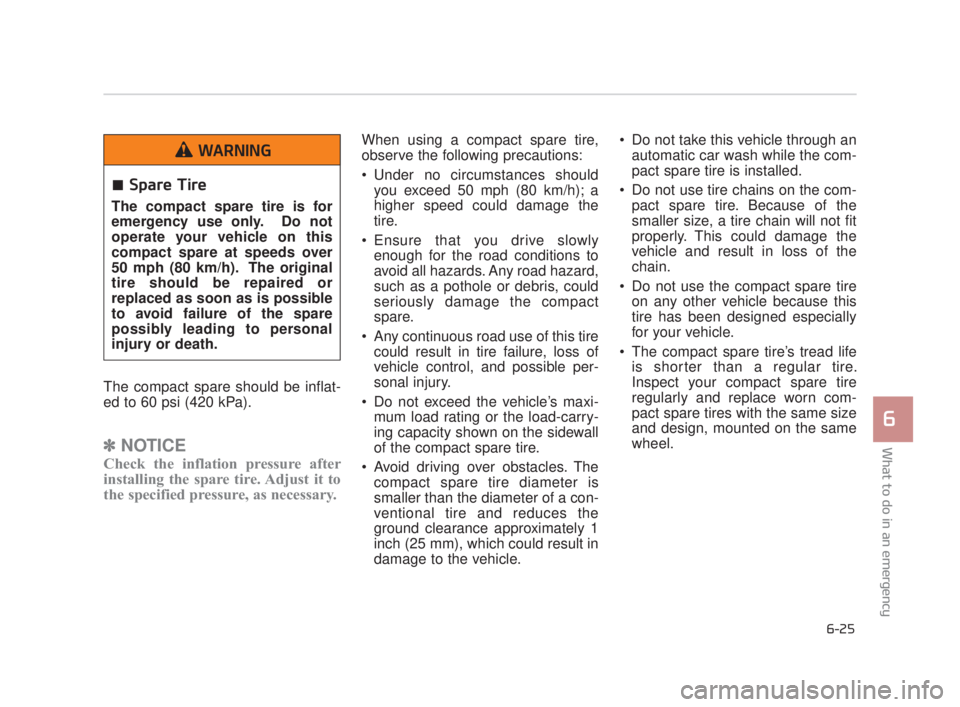
What to do in an emergency
6
6-25
The compact spare should be inflat-
ed to 60 psi (420 kPa).
✽ NOTICE
Check the inflation pressure after
installing the spare tire. Adjust it to
the specified pressure, as necessary.
When using a compact spare tire,
observe the following precautions:
Under no circumstances should
you exceed 50 mph (80 km/h); a
higher speed could damage the
tire.
Ensure that you drive slowly enough for the road conditions to
avoid all hazards. Any road hazard,
such as a pothole or debris, could
seriously damage the compact
spare.
Any continuous road use of this tire could result in tire failure, loss of
vehicle control, and possible per-
sonal injury.
Do not exceed the vehicle’s maxi- mum load rating or the load-carry-
ing capacity shown on the sidewall
of the compact spare tire.
Avoid driving over obstacles. The compact spare tire diameter is
smaller than the diameter of a con-
ventional tire and reduces the
ground clearance approximately 1
inch (25 mm), which could result in
damage to the vehicle. Do not take this vehicle through an
automatic car wash while the com-
pact spare tire is installed.
Do not use tire chains on the com- pact spare tire. Because of the
smaller size, a tire chain will not fit
properly. This could damage the
vehicle and result in loss of the
chain.
Do not use the compact spare tire on any other vehicle because this
tire has been designed especially
for your vehicle.
The compact spare tire’s tread life is shorter than a regular tire.
Inspect your compact spare tire
regularly and replace worn com-
pact spare tires with the same size
and design, mounted on the same
wheel.
Spare Tire
The compact spare tire is for
emergency use only. Do not
operate your vehicle on this
compact spare at speeds over
50 mph (80 km/h). The original
tire should be repaired or
replaced as soon as is possible
to avoid failure of the spare
possibly leading to personal
injury or death.
WARNING
KH USA 6:2018 4/12/2017 10:22 AM Page 25
Page 401 of 544
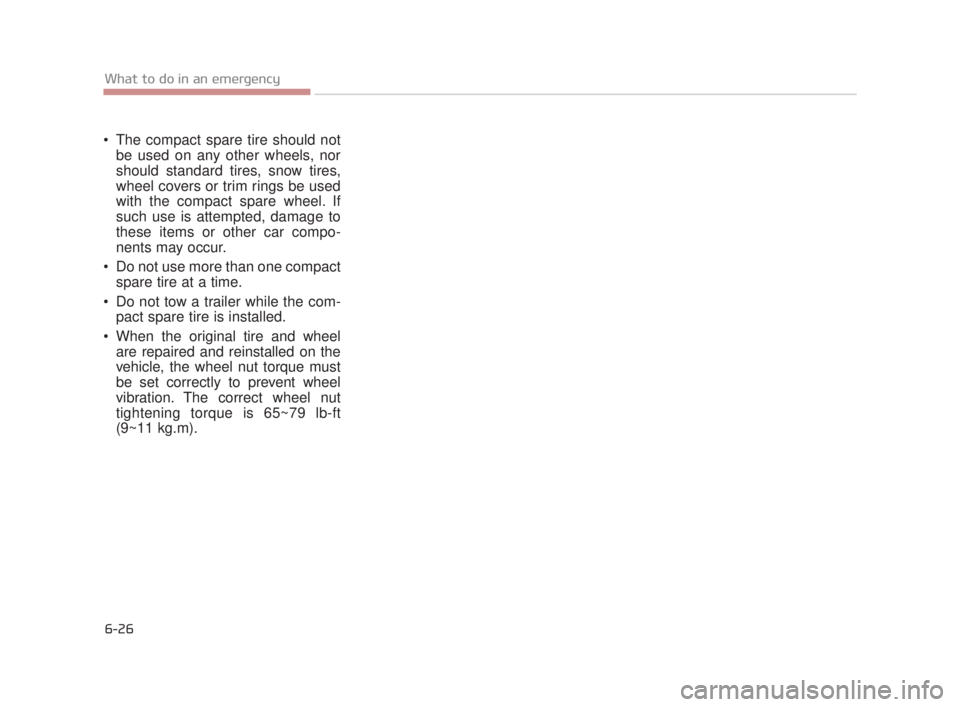
6-26
What to do in an emergency
The compact spare tire should notbe used on any other wheels, nor
should standard tires, snow tires,
wheel covers or trim rings be used
with the compact spare wheel. If
such use is attempted, damage to
these items or other car compo-
nents may occur.
Do not use more than one compact spare tire at a time.
Do not tow a trailer while the com- pact spare tire is installed.
When the original tire and wheel are repaired and reinstalled on the
vehicle, the wheel nut torque must
be set correctly to prevent wheel
vibration. The correct wheel nut
tightening torque is 65~79 lb-ft
(9~11 kg.m).
KH USA 6:2018 4/12/2017 10:22 AM Page 26
Page 403 of 544

6-28
What to do in an emergency
TOWING
Towing service
If emergency towing is necessary,
we recommend having it done by an
authorized K900 Kia dealer or a
commercial tow-truck service.
Proper lifting and towing procedures
are necessary to prevent damage to
the vehicle. The use of wheel dollies
or flatbed is recommended.It is acceptable to tow the vehicle
with the front wheels on the ground
(without dollies) and the rear wheels
off the ground.
If any of the loaded wheels or sus-
pension components are damaged
or the vehicle is being towed with the
rear wheels on the ground, use a
towing dolly under the rear wheels.
When being towed by a commercial
tow truck and wheel dollies are not
used, the rear of the vehicle should
always be lifted, not the front.
Ensure any metal parts on the tie-
down straps do not contact painted
surfaces or the face of the wheels.
Do not place straps over the body panels or through the wheels.
OKH064014N
A
B
C dolly
OKH065027N
Attaching straps to the chasis,
suspension or other parts of
the body can cause damage.
CAUTION
Side and curtain air bag
If your vehicle is equipped with
side and curtain air bag, set the
ignition switch to LOCK or ACC
position when the vehicle is
being towed. The side and cur-
tain air bag may deploy when
the ignitions is ON, and the
rollover sensor detects the situ-
ation as a rollover.
WARNING
KH USA 6:2018 4/12/2017 10:22 AM Page 28
Page 404 of 544
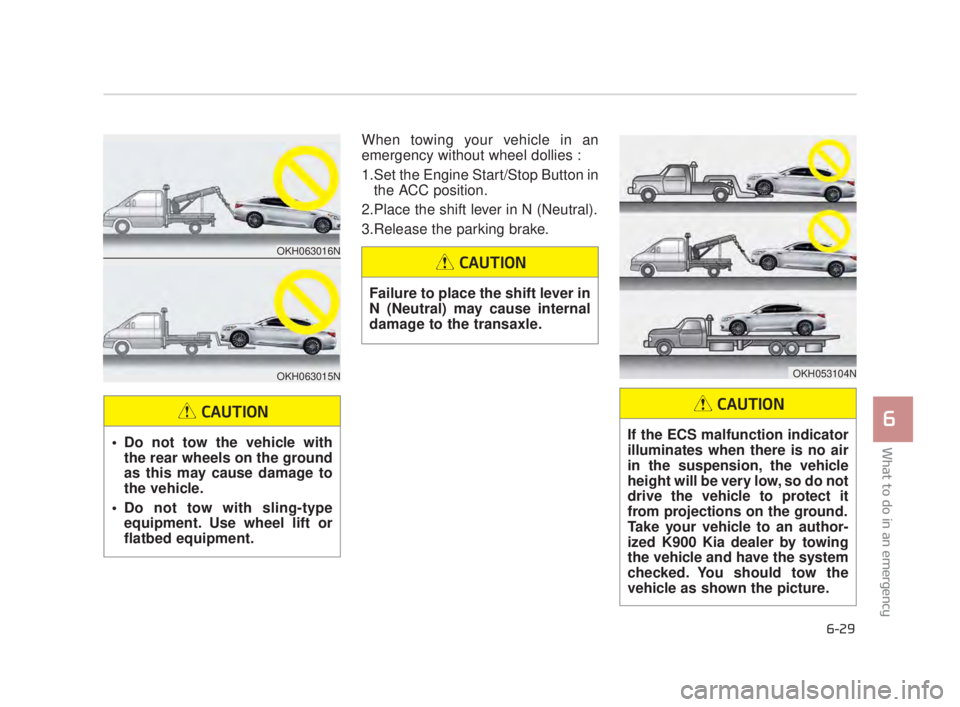
What to do in an emergency
6
6-29
When towing your vehicle in an
emergency without wheel dollies :
1.Set the Engine Start/Stop Button inthe ACC position.
2.Place the shift lever in N (Neutral).
3.Release the parking brake.
OKH063016N
OKH063015N
Do not tow the vehicle with the rear wheels on the ground
as this may cause damage to
the vehicle.
Do not tow with sling-type equipment. Use wheel lift or
flatbed equipment.
CAUTION
OKH053104N
Failure to place the shift lever in
N (Neutral) may cause internal
damage to the transaxle.
CAUTION
If the ECS malfunction indicator
illuminates when there is no air
in the suspension, the vehicle
height will be very low, so do not
drive the vehicle to protect it
from projections on the ground.
Take your vehicle to an author-
ized K900 Kia dealer by towing
the vehicle and have the system
checked. You should tow the
vehicle as shown the picture.
CAUTION
KH USA 6:2018 4/12/2017 10:22 AM Page 29
Page 406 of 544
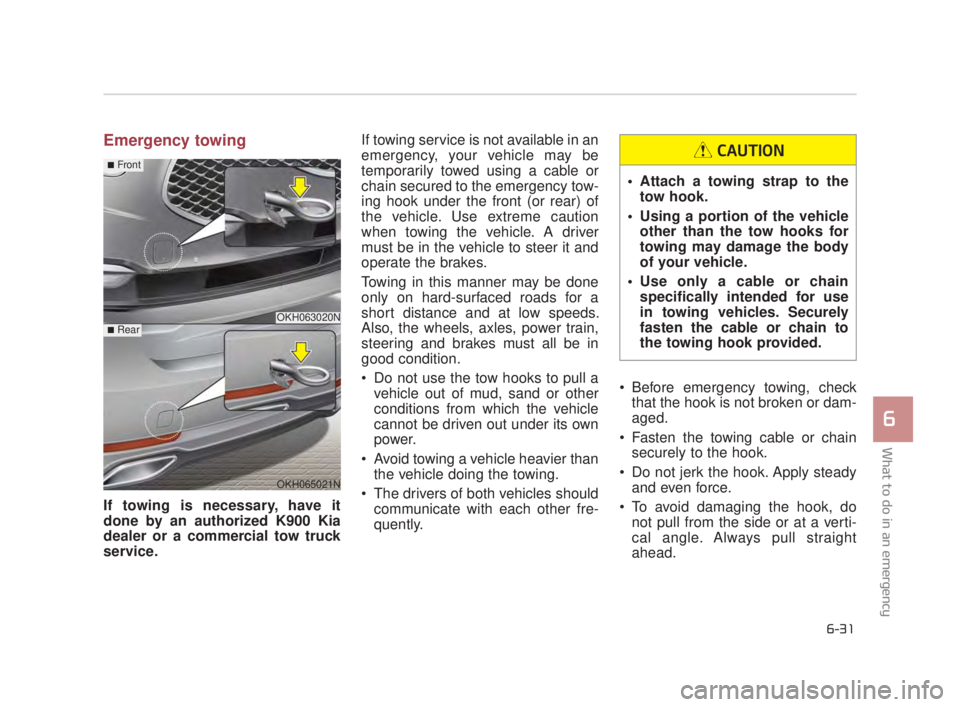
What to do in an emergency
6
6-31
Emergency towing
If towing is necessary, have it
done by an authorized K900 Kia
dealer or a commercial tow truck
service. If towing service is not available in an
emergency, your vehicle may be
temporarily towed using a cable or
chain secured to the emergency tow-
ing hook under the front (or rear) of
the vehicle. Use extreme caution
when towing the vehicle. A driver
must be in the vehicle to steer it and
operate the brakes.
Towing in this manner may be done
only on hard-surfaced roads for a
short distance and at low speeds.
Also, the wheels, axles, power train,
steering and brakes must all be in
good condition.
Do not use the tow hooks to pull a
vehicle out of mud, sand or other
conditions from which the vehicle
cannot be driven out under its own
power.
Avoid towing a vehicle heavier than the vehicle doing the towing.
The drivers of both vehicles should communicate with each other fre-
quently. Before emergency towing, check
that the hook is not broken or dam-
aged.
Fasten the towing cable or chain securely to the hook.
Do not jerk the hook. Apply steady and even force.
To avoid damaging the hook, do not pull from the side or at a verti-
cal angle. Always pull straight
ahead.
OKH063020N
OKH065021N
■Front
■Rear
Attach a towing strap to thetow hook.
Using a portion of the vehicle other than the tow hooks for
towing may damage the body
of your vehicle.
Use only a cable or chain specifically intended for use
in towing vehicles. Securely
fasten the cable or chain to
the towing hook provided.
CAUTION
KH USA 6:2018 4/12/2017 10:22 AM Page 31
Page 407 of 544
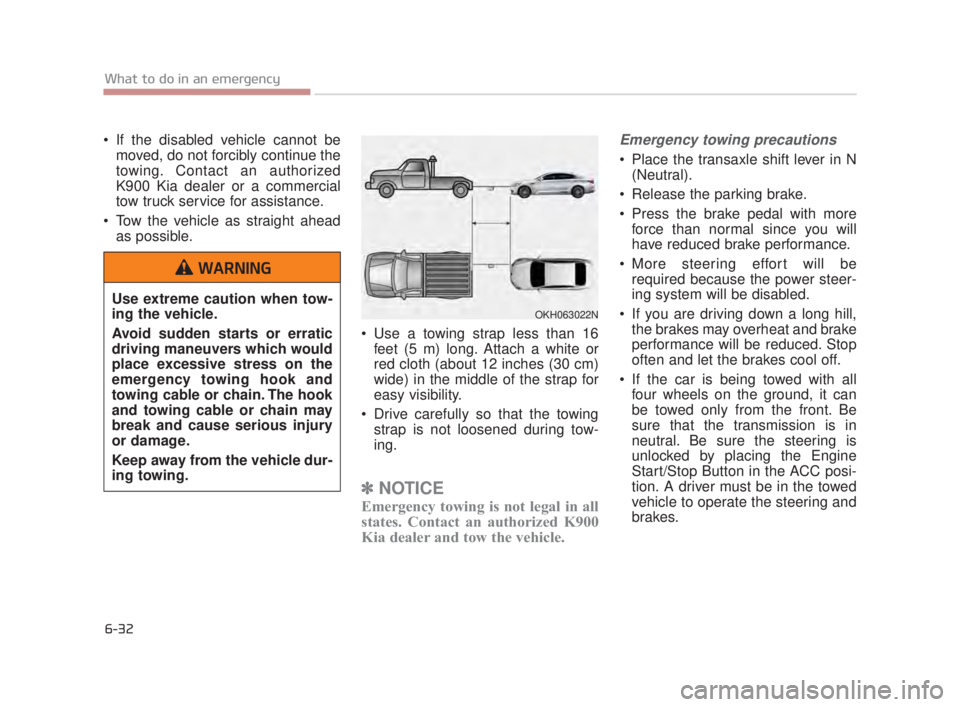
6-32
What to do in an emergency
If the disabled vehicle cannot bemoved, do not forcibly continue the
towing. Contact an authorized
K900 Kia dealer or a commercial
tow truck service for assistance.
Tow the vehicle as straight ahead as possible.
Use a towing strap less than 16feet (5 m) long. Attach a white or
red cloth (about 12 inches (30 cm)
wide) in the middle of the strap for
easy visibility.
Drive carefully so that the towing strap is not loosened during tow-
ing.
✽ NOTICE
Emergency towing is not legal in all
states. Contact an authorized K900
Kia dealer and tow the vehicle.
Emergency towing precautions
Place the transaxle shift lever in N
(Neutral).
Release the parking brake.
Press the brake pedal with more force than normal since you will
have reduced brake performance.
More steering effort will be required because the power steer-
ing system will be disabled.
If you are driving down a long hill, the brakes may overheat and brake
performance will be reduced. Stop
often and let the brakes cool off.
If the car is being towed with all four wheels on the ground, it can
be towed only from the front. Be
sure that the transmission is in
neutral. Be sure the steering is
unlocked by placing the Engine
Start/Stop Button in the ACC posi-
tion. A driver must be in the towed
vehicle to operate the steering and
brakes.
Use extreme caution when tow-
ing the vehicle.
Avoid sudden starts or erratic
driving maneuvers which would
place excessive stress on the
emergency towing hook and
towing cable or chain. The hook
and towing cable or chain may
break and cause serious injury
or damage.
Keep away from the vehicle dur-
ing towing.
WARNING
OKH063022N
KH USA 6:2018 4/12/2017 10:22 AM Page 32
Page 409 of 544
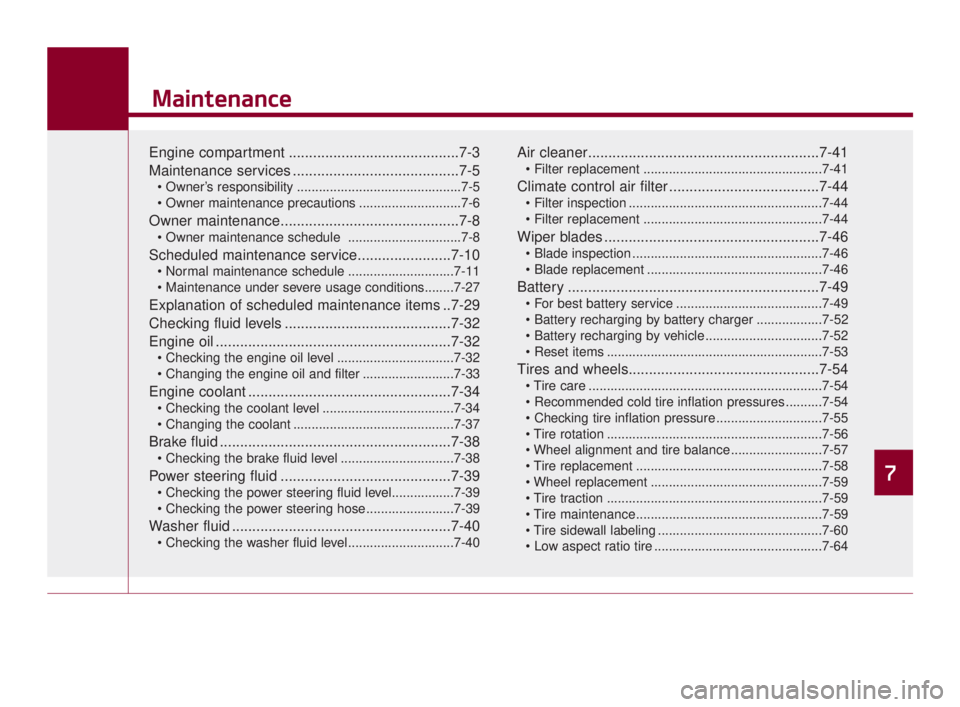
7
Maintenance
Engine compartment ..........................................7-3
Maintenance services .........................................7-5
.............................................7-5
............................7-6
Owner maintenance............................................7-8
...............................7-8
Scheduled maintenance service.......................7-10
.............................7-11
Explanation of scheduled maintenance items ..7-29
Checking fluid levels .........................................7-32
Engine oil ..........................................................7-32
................................7-32
.........................7-33
Engine coolant ..................................................7-34
....................................7-34
............................................7-37
Brake fluid .........................................................7-38
...............................7-38
Power steering fluid ..........................................7-39
Washer fluid ......................................................7-40
.............................7-40
Air cleaner.........................................................7-41
.................................................7-41
Climate control air filter .....................................7-44
.....................................................7-44
.................................................7-44
Wiper blades .....................................................7-46
....................................................7-46
................................................7-46
Battery ..............................................................7-49
........................................7-49
..................7-52
................................7-52
...........................................................7-53
Tires and wheels...............................................7-54
................................................................7-54
..........7-54
.............................7-55
...........................................................7-56
.........................7-57
...................................................7-58
...............................................7-59
...........................................................7-59
.............................................7-60
..............................................7-64
7
KH USA 7:2018 4/14/2017 6:36 PM Page 1
Page 416 of 544
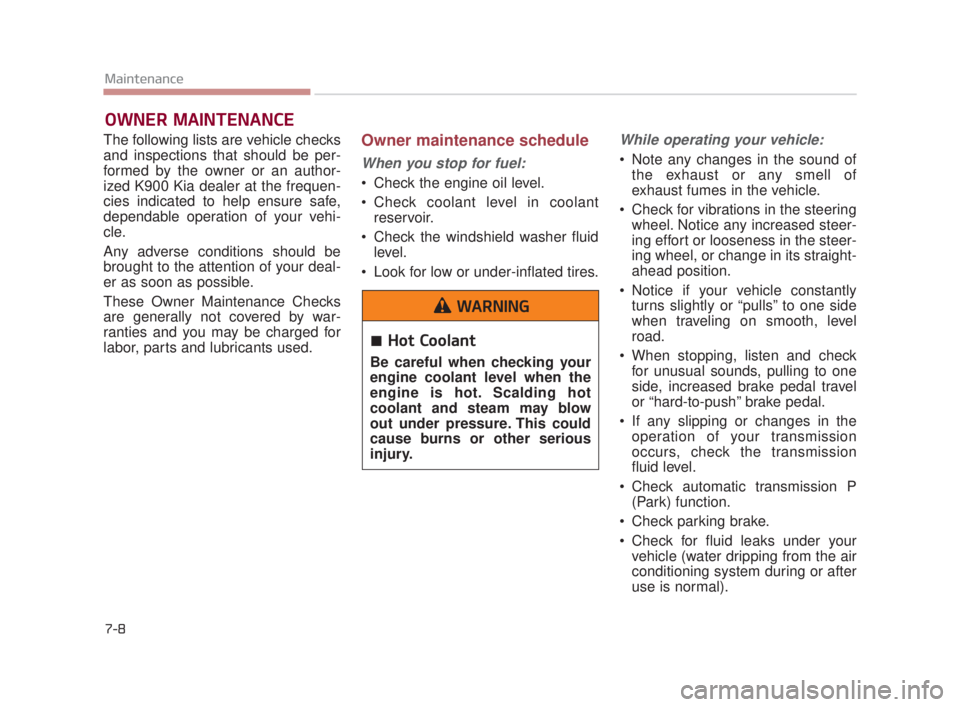
7-8
Maintenance
OWNER MAINTENANCE
The following lists are vehicle checks
and inspections that should be per-
formed by the owner or an author-
ized K900 Kia dealer at the frequen-
cies indicated to help ensure safe,
dependable operation of your vehi-
cle.
Any adverse conditions should be
brought to the attention of your deal-
er as soon as possible.
These Owner Maintenance Checks
are generally not covered by war-
ranties and you may be charged for
labor, parts and lubricants used. Owner maintenance schedule
When you stop for fuel:
Check the engine oil level.
Check coolant level in coolantreservoir.
Check the windshield washer fluid level.
Look for low or under-inflated tires.
While operating your vehicle:
Note any changes in the sound of the exhaust or any smell of
exhaust fumes in the vehicle.
Check for vibrations in the steering wheel. Notice any increased steer-
ing effort or looseness in the steer-
ing wheel, or change in its straight-
ahead position.
Notice if your vehicle constantly turns slightly or “pulls” to one side
when traveling on smooth, level
road.
When stopping, listen and check for unusual sounds, pulling to one
side, increased brake pedal travel
or “hard-to-push” brake pedal.
If any slipping or changes in the operation of your transmission
occurs, check the transmission
fluid level.
Check automatic transmission P (Park) function.
Check parking brake.
Check for fluid leaks under your vehicle (water dripping from the air
conditioning system during or after
use is normal).
Hot Coolant
Be careful when checking your
engine coolant level when the
engine is hot. Scalding hot
coolant and steam may blow
out under pressure. This could
cause burns or other serious
injury.
WARNING
KH USA 7:2018 4/14/2017 6:37 PM Page 8